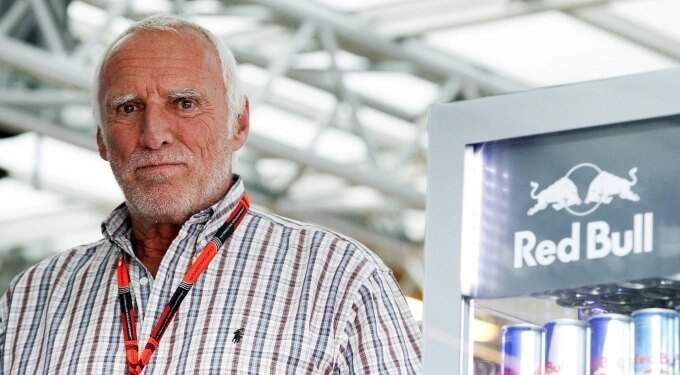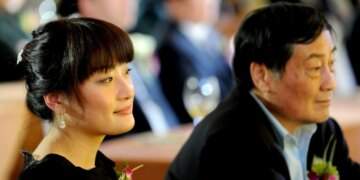Mateschitz was born in 1944 in Styria, Austria, to parents who were elementary school teachers and separated when he was young.
As a result, from his teenage years, Mateschitz lived independently away from his family.
He spent 10 years earning a bachelor’s degree in marketing from the Vienna University of Economics and Business, a prolonged journey that reflected his belief that youth should be about experiences and exploration.
During that decade, he worked as a ski instructor and took on manual labor jobs to support himself, according to C-Suite Network.
 |
|
This photograph taken on June 19, 2015 shows Red Bull co-founder and CEO Dietrich Mateschitz after the first practic session at the Austrian Formula One Grand Prix at the Red Bull Ring in Spielberg. Photo by AFP |
After graduating at age 28, Mateschitz joined several multinational companies, with his first job being a salesman marketing detergents for Unilever. He later became the international marketing director for German hygiene products brand Blendax.
After nearly 12 years in the corporate world, he began to feel burned out by its monotony. He once told Bloomberg that all the flights, suits, hotels, and bars all started to feel the same, describing them with the color “gray.”
“I asked myself whether I wanted to spend the next decade as I’d spent the previous one,” he said.
During a business trip to Thailand in 1982, he happened to discover a local energy drink called Krating Daeng, which means “red bull” in Thai.
This medicinal-tasting and intensely sweet drink was commonly used by local truck drivers to combat fatigue.
Mateschitz immediately recognized its potential as an instant remedy for the growing problem of fatigue among Westerners. Hence, he decided to quit his job and begin his entrepreneurial journey.
In 1984, Mateschitz returned to Thailand and persuaded Chaleo Yoovidhya, who invented Krating Daeng, to each invest US$500,000 to establish Red Bull.
They each took a 49% stake in the new business, with the remaining 2% going to Chaleo’s son, Chalerm Yoovidhya.
However, the product did not gain approval in Austria at first as it tasted too sweet, contained unfamiliar ingredients and had unusual packaging. Most market research firms at the time gave the product negative reviews, criticizing its name, flavor and brand image.
In its first two years, Red Bull lost over $1 million. With no advertising budget, Mateschitz had to borrow from friends and use every connection he had to keep the company afloat.
Subsequently, instead of simply trying to sell a strange drink, Mateschitz chose to market it as a lifestyle. He targeted young people, students, partygoers, and especially the extreme sports community.
With the help of Johannes Kastner, Mateschitz’s old friend from the marketing industry, he created the now-iconic logo featuring two charging bulls and the slogan “Red Bull Gives You Wings.” The catchphrase symbolized freedom, boldness, and pushing beyond limits.
As Austria had yet to approve the product, he took Red Bull to Hungary, Germany, and the U.K. after adjusting the flavor, adding carbonation, and redesigning the packaging into a slimmer can with its signature silver-blue color.
Step by step, Mateschitz carved out a new niche: a premium energy drink tailored to an active lifestyle.
Red Bull began sponsoring extreme sports events, organizing contests like Flugtag—where participants build homemade flying machines and launch them over water—and supporting hundreds of extreme sports athletes worldwide.
Each event was an opportunity to advertise the brand without relying on traditional methods.
The pinnacle of this strategy was Austrian skydiver Felix Baumgartner’s jump from the edge of space during the Red Bull Stratos mission—an event that was both daring and inspiring, attracting hundreds of millions of views worldwide.
Baumgartner performed a freefall jump from an altitude of 39,000 meters, setting a world record by breaking the sound barrier unaided by a vehicle.
 |
|
Red Bull owner Dietrich Mateschitz (R) congratulates Red Bull Formula One driver Sebastian Vettel of Germany for winning the championship and the Abu Dhabi Grand Prix at the Yas Marina circuit November 14, 2010. Photo by Reuters |
Red Bull was no longer just an energy drink seller, it produced videos, magazines, and sports and music content built around the spirit of “giving you wings” through its media unit, Red Bull Media House.
In 2012, Forbes estimated Mateschitz’s net worth to be $5.3 billion.
When he passed away in 2022 at the age of 78 due to cancer, his firm was selling over 9.8 billion cans annually and was present in more than 170 countries. He owned the Red Bull Racing Formula One team, football clubs in the U.S. and Europe, and a collection of vintage aircraft.
Despite his success, Mateschitz remained highly private, according to Reuters. He lived in Salzburg with his longtime partner and rarely gave interviews.
“When we first started, we said there is no existing market for Red Bull,” Mateschitz once told Forbes. “But Red Bull will create it.”
Enterprise Viewpoint cites Mateschitz’s entrepreneurial journey as a textbook example of Apple co-founder Steve Jobs’s quote: “I’m convinced that about half of what separates successful entrepreneurs from the nonsuccessful ones is pure perseverance.”
Mateschitz did not start young, had no exceptional financial backing and did not enter an industry he was familiar with.
But with sharp instincts, vision, and a level of persistence that bordered on stubbornness, he turned an exotic can of drink into a global symbol of energy, boldness, and surpassing limits.





